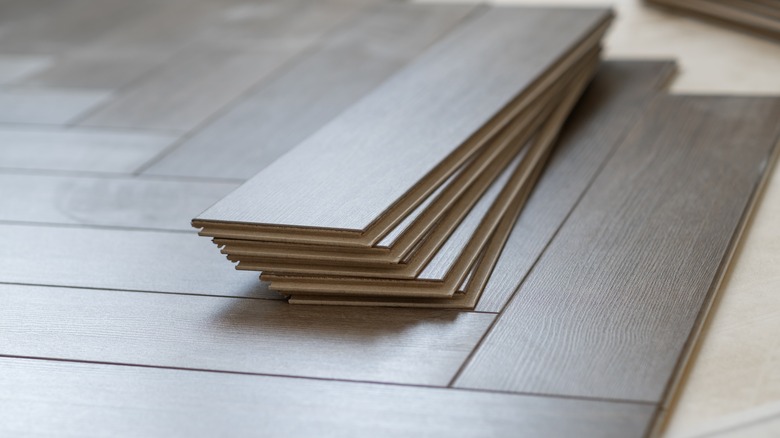How To Decide Whether Herringbone Or Parquet Hardwood Floors Suit Your Style
If herringbone and parquet are your top two hardwood flooring design choices, you might be a bit confused about which option is an ideal fit for your style. Would the interlocking V-shaped wood panels in herringbone flooring complement your home best, or is the intricate geometric pattern found in parquet flooring the better option for you? Luckily, you don't have to make the decision alone. Consider the advice shared by Skylar Bartlett, owner at Kreer Construction. While speaking exclusively to House Digest, the expert explained that you need to evaluate factors like design scheme, room size, and your overall design goals to determine whether to go with herringbone or parquet hardwood floors.
Bartlett outlined the differences between the two options so that you have a better idea of which would work for you given your home layout and personal preferences. "Herringbone features a zigzag design with a 90-degree angle," she explained. "Parquet includes various geometric layouts like chevron, basketweave, or squares." The installation process for herringbone and parquet are different too. "Herringbone is repetitive and precise," Bartlett said. "Parquet requires custom layouts, making it more labor-intensive." Since these two gorgeous hardwood floor patterns are so different all around, you may want to take Bartlett's advice into account to avoid making the wrong choice.
Evaluate your home's layout and design scheme
Take a look at your home's existing layout in order to decide whether herringbone or parquet hardwood floors or better for your home. According to Bartlett, the first factor you will need to evaluate is the style of the space. "Herringbone is timeless and works well in classic or modern spaces with clean lines, while parquet patterns like basketweave or chevron suit more formal or eclectic interiors," she explained while speaking exclusively to House Digest. The second factor to consider is the size of the room you plan to install the flooring in. "Herringbone elongates the room and adds depth, making it ideal for narrow or small spaces. Parquet's intricate designs can make larger rooms feel more luxurious," Bartlett said. The third factor is whether you are aiming for consistency or would rather make a statement. She explained that herringbone provides consistency and subtlety, while parquet makes more of a statement due to its bold pattern.
Keep in mind that these two different types of wood flooring also have different effects on a space. As for herringbone, it brings movement into a room. "Its diagonal pattern gives a refined, yet approachable feel and helps guide the eye, adding depth," Bartlett also said of the design. Parquet provides more texture and makes your home feel more sophisticated. "It draws attention and adds an artistic flair, which can make the room feel more curated or grand," the expert added.
The pros and cons of herringbone and parquet hardwood floors
There are plenty of other things to consider before installing hardwood flooring, like evaluating the pros and cons of the designs. While speaking exclusively to House digest, Bartlett revealed that the pros of herringbone is that it's timeless, versatile, and able to enhance depth. She shared that it's also more compatible with a wide range of home design styles. However, watch out for herringbone if you are looking to install your wood floors in a large room. Bartlett revealed that one of the cons of this design is that it's less impactful in bigger spaces. It can also be more expensive to install than straight planks of wood.
The pros of parquet have to do with its intricate pattern. Bartlett explained it's unique and brings an artistic touch into a home. The expert shared that it also works well in formal spaces and makes a statement. As for the cons, parquet is pricey to install, according to Bartlett. She went on to reveal that the flooring, unlike herringbone, isn't the best for small rooms.


